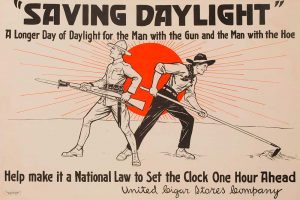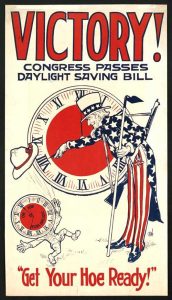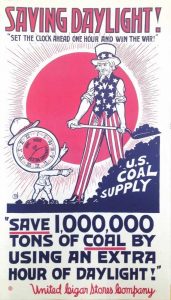Small Home Gazette, Spring 2020
History Brief: Saving Daylight Will Win the War!
It was not until WWI that the concept took hold. In the U.S., the idea was formally adopted and implemented on March 31, 1918, in hope that people would spend more time outside and less time inside with the lights on at night, thus conserving fuel.
Farmers were against it. The sun, not the clock, dictated farmers’ schedules, and daylight saving was disruptive. Agrarian interests led the fight to repeal it in 1919. But state governments were allowed to decide whether they continued with the time change, causing widespread confusion, especially in transport and broadcasting.

 National daylight saving time returned during WWII, but after its repeal at war’s end, the state-by-state confusion resumed. Order finally came in 1966 with the Uniform Time Act, which specified the start and end dates. (States still have the option of remaining on standard time year-round.)
National daylight saving time returned during WWII, but after its repeal at war’s end, the state-by-state confusion resumed. Order finally came in 1966 with the Uniform Time Act, which specified the start and end dates. (States still have the option of remaining on standard time year-round.)
The original idea was to save electricity. Still relevant today? If we change course again, will the confusion return? Only time will tell.









 On Sunday, March 8, at 2 p.m., Minnesotans set their clocks forward one hour, losing an hour of sleep while adding an hour of daylight to the evenings.
On Sunday, March 8, at 2 p.m., Minnesotans set their clocks forward one hour, losing an hour of sleep while adding an hour of daylight to the evenings.

